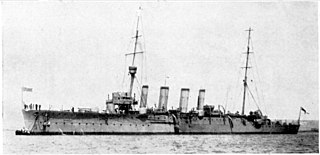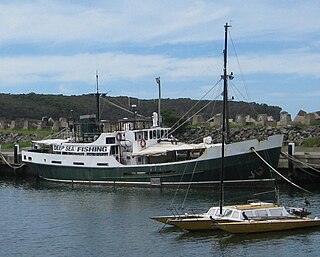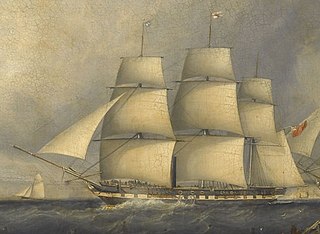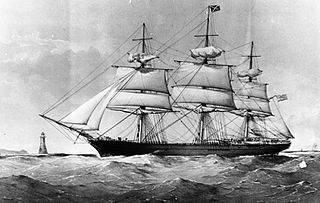
A clipper was a type of mid-19th-century merchant sailing vessel, designed for speed. Clippers were generally narrow for their length, small by later 19th century standards, could carry limited bulk freight, and had a large total sail area. "Clipper" does not refer to a specific sailplan; clippers may be schooners, brigs, brigantines, etc., as well as full-rigged ships. Clippers were mostly constructed in British and American shipyards, though France, Brazil, the Netherlands and other nations also produced some. Clippers sailed all over the world, primarily on the trade routes between the United Kingdom and China, in transatlantic trade, and on the New York-to-San Francisco route around Cape Horn during the California Gold Rush. Dutch clippers were built beginning in the 1850s for the tea trade and passenger service to Java.

HMVS Cerberus is a breastwork monitor that served in the Victoria Naval Forces, the Commonwealth Naval Forces (CNF), and the Royal Australian Navy (RAN) between 1871 and 1924.

HMAS Geranium was an Arabis-class sloop built in Scotland and launched in 1915. The ship was operated by the Royal Navy as a minesweeper from 1915 until 1919, when she was transferred to the Royal Australian Navy (RAN) for use as a survey ship between 1919 and 1927. The ship was decommissioned in 1927 and scrapped during 1932, with the remains scuttled in 1935.

HMAS Psyche was a Pelorus-class protected cruiser built for the Royal Navy at the end of the 19th century. Initially operating on the North America and West Indies Station, the cruiser was transferred to the Australian Squadron in 1903, and remained there until the Royal Australian Navy (RAN) took over responsibility in 1913. After a stint in New Zealand waters and involvement in the Occupation of German Samoa, Psyche was paid off in 1915.

HMAS Brisbane was a Town class light cruiser of the Royal Australian Navy (RAN). Built in Sydney between 1913 and 1916 to the Chatham subtype design, Brisbane operated in the Indian Ocean, Pacific Ocean, and Australian coastal waters during World War I.

HMAS Melbourne was a Town class light cruiser operated by the Royal Australian Navy (RAN). The ship was laid down by Cammell Laird at Birkenhead in England in 1911, launched in 1912 and commissioned in 1913. At the start of World War I, Melbourne was involved in attempts to locate the German East Asia Squadron, and participated in the capture of German colonies in the Pacific, before being assigned to the North America and West Indies Stations. In 1916, the cruiser joined the Grand Fleet in the North Sea, where she remained for the remainder of the war. Melbourne spent late 1919 and early 1920 in reserve, then was flagship of the Royal Australian Navy from 1920 until 1928, except for a second period in reserve during 1924 and 1925. HMAS Melbourne paid off in the United Kingdom on 23 April 1928, and was scrapped in 1929.

HMAS Vampire was the third of three Australian-built Daring class destroyers serving in the Royal Australian Navy (RAN). One of the first all-welded ships built in Australia, she was constructed at Cockatoo Island Dockyard between 1952 and 1959, and was commissioned into the RAN a day after completion.

HMAS Manoora was a passenger liner that served in the Royal Australian Navy (RAN) during World War II. She was built in Scotland in 1935 for the Cairns to Fremantle coastal passenger run for the Adelaide Steamship Company. She was requisitioned by the RAN for naval service in 1939. Manoora was initially converted into an armed merchant cruiser (AMC), operating primarily in Australian, New Guinea, and Pacific waters, with deployments to Singapore and the Bay of Bengal.
HMAS Vendetta was one of three Daring-class destroyers built for and operated by the Royal Australian Navy (RAN). The destroyer was built by Williamstown Naval Dockyard and entered service in 1958. During her early career, Vendetta was deployed to the Far East Strategic Reserve on multiple occasions. In 1965 and 1966, the destroyer undertook deterrence patrols during the Indonesia-Malaysia Confrontation. Along with several runs escorting the troop transport HMAS Sydney to South Vietnam, from late 1969 to early 1970 Vendetta was assigned to combat operations and became the only Australian-built warship to serve in a shore bombardment role during the Vietnam War.

HMAS Otway was an Oberon-class submarine of the Royal Australian Navy (RAN). One of the first four Oberon-class boats ordered for the RAN, Otway was built in Scotland during the mid-1960s, and commissioned into naval service in 1968. The submarine was decommissioned in 1994. The submarine's upper casing, fin, and stern are preserved at Holbrook, New South Wales.

HMAS Banks was an Explorer class general-purpose vessel of the Royal Australian Navy (RAN), serving in a range of capacities from 1960 until 1995. She was named in honour of Sir Joseph Banks, the botanist aboard HM Bark Endeavour during the discovery of the eastern coast of Australia in 1770.

HMS Otway was an Odin-class submarine of the Royal Australian Navy (RAN) and Royal Navy (RN).

In the middle third of the 19th Century, the clippers which carried cargoes of tea from China to Britain would compete in informal races to be first ship to dock in London with the new crop of each season. The Great Tea Race of 1866 was keenly followed in the press, with an extremely close finish. Taeping docked 28 minutes before Ariel - after a passage of more than 14,000 miles. Ariel had been ahead when the ships were taken in tow by steam tugs off Deal, but after waiting for the tide at Gravesend the deciding factor was the height of tide at which one could enter the different docks used by each ship. The third finisher, Serica, docked an hour and 15 minutes after Ariel. These three ships had left China on the same tide and arrived at London 99 days later to dock on the same tide. The next to arrive, 28 hours later, was Fiery Cross, followed, the next day, by Taitsing.

København was a British-built, Danish-owned five-masted barque used as a naval training vessel until its disappearance after December 22, 1928. Built for the Danish East Asiatic Company in 1921, it was the world's largest sailing ship at the time, and primarily served for sail training of young cadets.

HMAS Ping Wo was a 3,105 tons former Indo-Chinese river steamer that was commissioned into the Royal Australian Navy (RAN) during World War II. The Chinese name translates to "Equitable Harmony". It was one of a group of vessels known as the "China Fleet" acquired by the RAN in similar circumstances.

HMS Penguin was an Osprey-class sloop. Launched in 1876, Penguin was operated by the Royal Navy from 1877 to 1881, then from 1886 to 1889. After being converted to a survey vessel, Penguin was recommissioned in 1890, and operated until 1908, when she was demasted and transferred to the Australian Commonwealth Naval Forces for use as a depot and training ship in Sydney Harbour. After this force became the Royal Australian Navy, the sloop was commissioned as HMAS Penguin in 1913. Penguin remained in naval service until 1924, when she was sold off and converted into a floating crane. The vessel survived until 1960, when she was broken up and burnt.

Vernon was a 911 tons paddle steamer built in 1839 by Greens' Blackwall Yard, London, for the Green Blackwall Line. After her engines proved uneconomic, she had her paddles removed and she was converted into a sailing vessel. She was used on the passenger trade to the Colonies in the 19th Century.

The Steam Yacht Ena is a steam yacht that was built in 1900 for Thomas Dibbs, the commodore of the Royal Sydney Yacht Squadron. It was used as his private vessel for entertaining guests on Sydney Harbour and Pittwater until the beginning of World War I. In 1917 the yacht was purchased by the Royal Australian Navy (RAN) and used as the auxiliary patrol vessel HMAS Sleuth in the waters around the Torres Strait and Thursday Island, before later being used as a training ship tender based in Sydney.

Yatala, 1,127 tons, was a clipper ship built in 1865 for the Orient Line. She traded to South Australia from London for seven years until she was wrecked on 27 March 1872, near Cape Grisnez, France. Until the advent of Torrens, she was arguably the fastest on the route. Her only master was Captain John Legoe, previously of Celestial and The Murray.

Darra was a barque-rigged clipper, built at Aberdeen and launched in 1865.





















